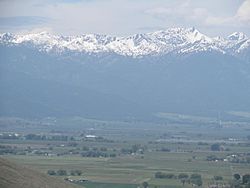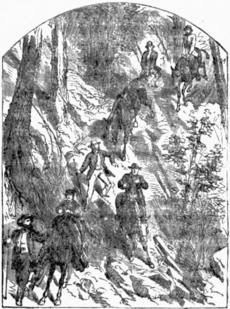Blue Mountains (Pacific Northwest) facts for kids
Quick facts for kids Blue Mountains |
|
|---|---|

Baker City, Oregon with the Blue Mountains in the background, seen from the National Historic Oregon Trail Interpretive Center observatory
|
|
| Highest point | |
| Peak | Sacajawea Peak Oregon |
| Elevation | 9,843 ft (3,000 m) |
| Dimensions | |
| Area | 15,000 sq mi (39,000 km2) |
| Geography | |
| Country | United States |
| States | Oregon, Washington |
The Blue Mountains are a mountain range in the western United States. You can find them mostly in northeastern Oregon, stretching into southeastern Washington.
This mountain range covers a huge area, about 15,000 square miles (38,850 km2). It goes from east and southeast of Pendleton, Oregon, all the way to the Snake River near the Oregon-Idaho border. The Blue Mountains are spread across nine counties in two states. These include Union, Umatilla, Grant, Baker, and Wallowa counties in Oregon. In Washington, they cover Walla Walla, Columbia, Garfield, and Asotin counties.
Did you know the Blue Mountains are home to the world's largest living thing? It's a giant fungus called Armillaria ostoyae! The mountains got their name because they look blue when you see them from far away.
Contents
What are the Blue Mountains Made Of?
The Blue Mountains are "uplift mountains." This means they were formed when parts of the Earth's crust pushed upwards. They contain some of Oregon's oldest rocks, some as old as 400 million years! These ancient rocks poke through younger layers of rock formed by lava flows.
These mountains are part of a bigger area called the Columbia River Plateau. This dry region is located east of the Cascade Range in Oregon and Washington. The Blue Mountains are actually made up of several smaller mountain ranges. These include the Ochoco Mountains, Maury Mountains, Greenhorn Mountains, Aldrich Mountains, Strawberry Range, Elkhorn Mountains, and Wallowa Mountains.
The tallest peak in the Blue Mountains is Sacajawea Peak in the Wallowa Mountains. It stands at 9,843 feet (3,000 meters) tall. Other high peaks are Rock Creek Butte at 9,106 feet (2,776 meters) and Strawberry Mountain at 9,042 feet (2,756 meters).
A Look Back in Time
Native American Homes
For thousands of years, Native American tribes lived in the river valleys and lower parts of the Blue Mountains. Tribes like the Walla Walla, Cayuse people, and Umatilla lived here. Today, they work together as the Confederated Tribes of the Umatilla Indian Reservation. The southern part of the Blue Mountains was home to different groups of the Northern Paiute.
These tribes came to the Blue Mountains to hunt and to catch salmon from the rivers. They even used to set small, controlled fires in the forests. This helped create open grassy areas, which attracted animals for hunting.
Pioneers and the Oregon Trail

In the mid-1800s, many settlers traveled west on the Oregon Trail. The Blue Mountains were a big challenge for them. They were often the last mountain range pioneers had to cross. After crossing, they would either reach southeastern Washington or follow the Columbia River Gorge to the end of the Oregon Trail in the Willamette Valley.
How People Travel Today
Today, it's much easier to cross the Blue Mountains. Interstate 84 goes right over the mountains, reaching a high point of 4,193 feet (1,278 meters). This highway connects La Grande and Pendleton. The town of Baker City is also located near the mountains.
U.S. Route 26 crosses the southern part of the range. It reaches an elevation of 5,098 feet (1,554 meters) at the Blue Mountain Summit. The Union Pacific Railroad also has a main train line that crosses the mountains. It goes between Portland, Oregon, and Pocatello, Idaho.
Animals of the Blue Mountains
The Blue Mountains are full of amazing wildlife! You can spot many different birds here, like bald eagles, northern spotted owls, and Lewis's woodpeckers. Many migratory birds also visit, and the riverbanks are important places for them to live.
Large mammals that roam the mountain grasslands include Rocky Mountain elk, bighorn sheep, and mule deer. The Hells Canyon area has the largest herd of Rocky Mountain elk in North America! The rivers are home to native fish like Chinook Salmon, Steelhead, and Bull Trout.
In Washington, the Blue Mountains are home to one of the state's ten elk herds. As of 2018, there were about 4,500 Rocky Mountain elk in this region. To help the elk population, hunting rules were put in place in 1989. These rules helped the number of male elk grow. In 2018, a new plan was suggested to keep the elk healthy and manage their habitats. This plan also aims to reduce conflicts between elk and people.
During winter, elk often prefer to stay on "moderately steep south slopes." These slopes are warmer and have less snow, making it easier for them to find food and stay warm.
Who Manages the Land?
The public lands in the Blue Mountains are managed by several groups. These include the United States Forest Service and the Bureau of Land Management. Private landowners and the Confederated Tribes of the Umatilla Indian Reservation also help manage the land.
Where are the Blue Mountains?
A large part of the Blue Mountains is found within national forests. These include the Malheur National Forest, Umatilla National Forest, and Wallowa–Whitman National Forest. There are also several special wilderness areas. These are wild, untouched places like the North Fork Umatilla Wilderness and the Strawberry Mountain Wilderness. The Wenaha–Tucannon Wilderness is unique because it sits right on the border between Oregon and Washington.
Rivers and Waterways
Many rivers flow through and drain the Blue Mountains. Some of these, like the Grande Ronde and Tucannon, flow into the Snake River. Other rivers, such as the John Day, Umatilla, and Walla Walla rivers, are tributaries of the Columbia. The southernmost part of the Blue Mountains is drained by the Silvies River.
See also
 In Spanish: Montañas Blue para niños
In Spanish: Montañas Blue para niños

